|
R.E.L. ( R esearch E nterprises L td 1945 WWII 7X50 Canadian manufactured British Military Binoculars C.G.B.40 M.A. |
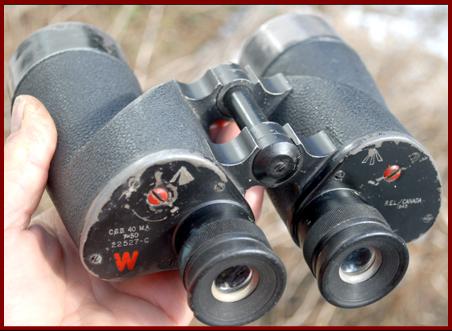
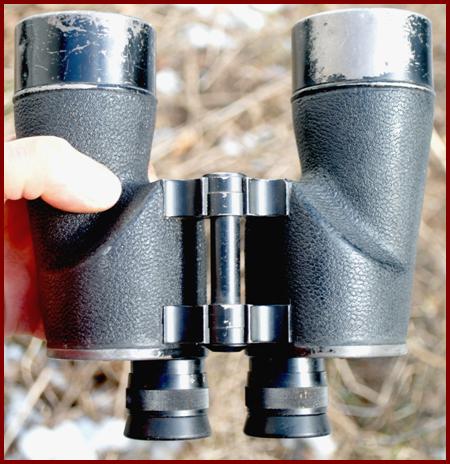
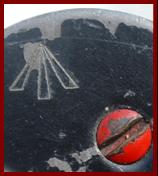
|
My 1945 dated R.E.L. 7x50 C.G.B.40 M.A. military binoculars were produced by Research Enterprises Ltd., a Canadian war factory that existed from late 1940-1946, and had been created by the Canadian Govt. National Research Council (NRC). The factory was located in what had formerly been the Leaside Aerodrome, near Toronto. R.E.L. produced around 25,000 of these 7x50 binoculars, which were used by Canada, the UK, and probably other commonwealth countries during WWII, and into the 1950’s. These particular binoculars are UK broad arrow War Dept military property marked, and also carry the red ’ W ” W aterproofed marking, and aso have the red painted screw heads indicating sealed/ removal by authorized repair personnel only. The R.E.L optics factory also produced 6x30 military binoculars, such as those below, and also produced several Canadian manufactured versions of the British #32 sniper scope used on the Lee Enfield #4 Mk1*T sniper rifles, as well as optical tank and artillery gunsights, and observer’s telescopes. R.E.L.’s electronics factory also produced a wide variety of radar systems, many of which were sold to the US military. |
|
1916 WWI Carl Zeiss London British Military Binoculars 6x24 No.3 Mk II made in Zeiss UK factory. |
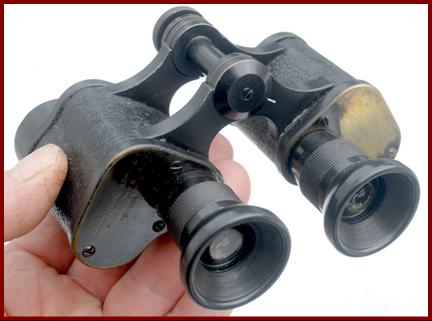

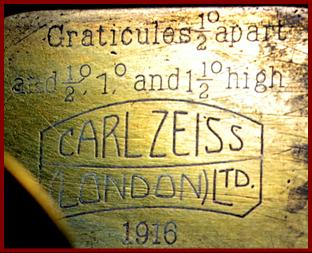
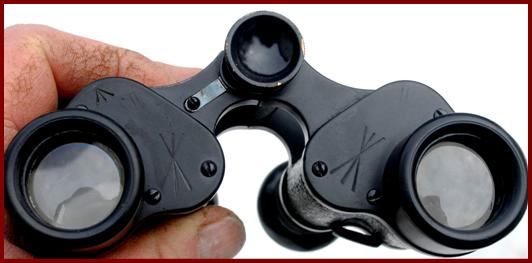



|
My Carl Zeiss London binoculars are a geopolitical binoculars paradox. They were produced in 1916 by the German Carl Zeiss Jena owned but British registered firm of Carl Zeiss London Ltd. (but which by 1916 had it’s German company directors forced out and replaced by British ones) at it’s Mill Hill London factory, fulfilling British Ministry of Defense govt. contracts, around two years after the UK had declared war on Germany on Aug. 4, 1914 (my grandmother’s brother enlisted in London that month) with those binoculars equipping UK troops fighting German troops. Zeiss London produced at least 923 of these binoculars in 1916. Slightly before the war had started, Carl Zeiss Jena ordered a stock of 700 binoculars from the London factory to be sent to Germany, but those shipments were blocked at British and Dutch ports, and the binoculars redirected to Woolrich arsenal in England. Actually the Carl Zeiss London factory had been producing British Military No 2 Mk I & Mk II and then No 3 Mk I and Mk II binoculars since 1909, when Carl Zeiss London Ltd. had been formed for that purpose. The British government subsequently forced the liquidation sale of the assets of Zeiss London Ltd. including the factory and all manufacturing equipment to the British Optics firm Ross Ltd. in January 1917, under the regulations of the January 1916 Trading With The Enemy (Amendment) Act for liquidating enemy owned property, with proceeds held in trust. Ross promptly continued to fill the Zeiss London Ltd. British Military contracts by producing around 50-75 binoculars per week, but with the subsequent binoculars branded as Ross. (information credit to Thomas Antoniades/ “ Carl Zeiss Presence in London”). |
|
“Binocular Prismatic No 3 Mark II magnification 6, (serial) No 1504”. The Mk II designates having the range graticule defined on the right plate, but the ocular was replaced with one from a No 3 MK1 model minus graticule, probably at the time of military disposal as a form of “demilitarizing”. |
|
One broad arrow British Military property mark at upper left, and two facing broad arrow property disposal marks |
|
1916 WWI Carl Zeiss London British Military Binoculars No.3 Mk 1 |

|
1951 A.B.L. 6x30 Belgian Military binoculars made by Optique et Instruments de Precision (O.I.P.) |
|
1926 Carl Zeiss Nedinsco Gravenhage (Dutch Manufactured) Ej ército Argentino / Argentine Military contract Infanteria y Cabelleria (Infantry and Cavalry) binoculars |
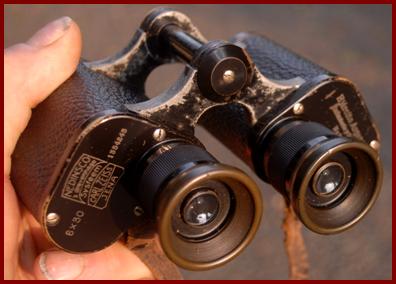
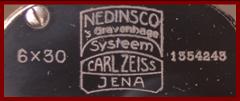


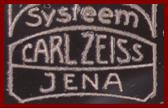

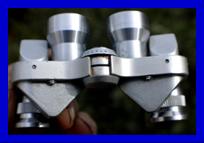
|
Japanese External Reverse Porro Prism Binoculars. WEBSITE MUSEUM |
|
OTHER BINOCULARS #8 & OPTICAL SIGHTS |
|
1960 Russian T3K 10x80 Flak and Observation Binoculars made by the Russian Novosibirsk Instrument Making Plant ( Новосибирский приборостроительный завод ) then Sold to Iraq, and then Combat Damaged by Airburst Shrapnel in the Iraq War of 1992 |
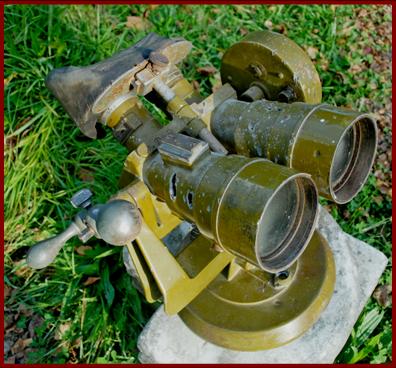
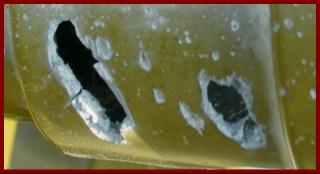
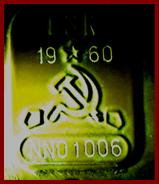
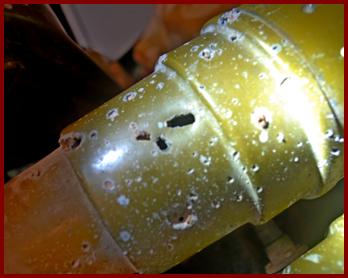
|
The Novosibirsk factory logo incorporates two pentagons with hammer sickle and uses “N” prefix serial numbers |
|
Some of the ferrous airburst anti personnel shrapnel that peppered these binoculars is still embedded in the metal of the objective tubes. |
|
These Russian 10x80 flak or anti aircraft binoculars were modeled on similar WWII German flak binoculars, and these were designed to be tripod mounted. Like the German models, these were also sometimes used as ground emplacement observation binoculars. These were probably brought back to the United States as a war trophy souvenir by a US soldier, and to me these particular binoculars are more interesting for their war damage and for the graphic insight they provide into the role of optics at war that they provide. The right side optics on these have targeting circles, and the base and the elevating mechanism both have directional and elevation readouts, which in it’s original flak or anti aircraft direction role give fire control corrections. |


|
1948-1952 U.S. Occupation German 7x50 Binoculars Made Under Contract for Canadian Simpson’s Department Store Chain by Hartmann Optik (Porlerim Model) |
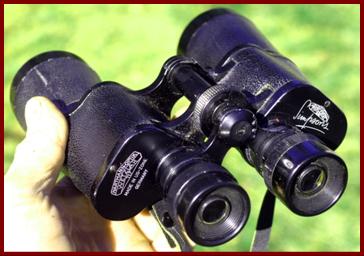
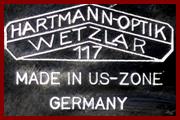
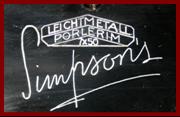
|
My Hartman-Optik 7x50 Porlerim binoculars are marked as having been made in the US Zone of Occupied Germany (1945-1952). Hartman was allowed to resume binocular production in post war Germany in 1948, and did so in 1948 with this Porlerim model line. These binoculars are marked as being made of the hard aluminum alloy “ LEIGHTMETALL ”. These binoculars also carry the stylized “ Simpson’s ” corporate logo of the Canadian Department store & mail order chain of Robert Simpson Ltd., which in 1952 had stores in Toronto, Montreal, Halifax, Regina, and London (Ontario) Canada. So Hartmann Optik made these under contract for the Simpson’s store chain at some point between 1948-1952 |
|
R.E.L. ( R esearch E nterprises L td.) 1944 WWII 6X30 Canadian manufactured British Military Binoculars C.G.B.53 G.A. |

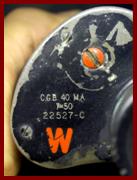
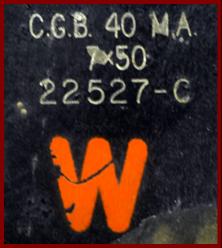
|
My 1944 dated Canadian manufactured R.E.L. 6x30 G.B.C.53 G.A. British military binoculars were produced by Research Enterprises Ltd., and share their history with the 7x50 R.E.L. 7x50 binoculars above. They are British War Dept broad arrow property marked, and these were obtained in England. There is online repetition that C.G.B. followed by a number represents “Contract Great Britain”, but this is questionable and it may be a Canadian specification or model designation, since many military binoculars used only by Canada, and/or not broad arrow UK property marked, also do have that same C.G.B. marking, with a number of model numbers. R.E.L. appears to have made 62,812 of these particular 6x30 binoculars. |
|
WWI 1914 Hungarian Zeiss Karoly Gy ö r M9/13 Z, K.U.K. Kaiserlich und Kongigliche Armee 6x 30 Austo Hungarian Army military binoculars made in the Zeiss Gy ö r Hungary factory. |
|
In 1911 the Carl Zeiss branch located in Vienna Austria established an assembly factory in Gyor Hungary, and in March 1914 it was incorporated as Zeiss Karoly R.T.(R é szv énytársasg/ public limited company). My Zeiss Karoly binoculars are marked 9/13 Z being a 1913 modification of the Zeiss 1909 model, and are marked 6 Facht , or 6 power. They are marked Feldstecher mit Skala (field glasses with scale, in German). My 7/31/1914 dated binoculars were made for the Austro Hungarian Army, or K.U.K. Kaiserlich und Kongigliche Armee (literally Imperial and Royal Army), and contain a right side cross hair. Credit: Zeiss Historica, Vol 12 No 1 |
|
Zeiss U.S. Navy marked 8x Field Glasses US license made by Bausch & Lomb , patent date 1897 |
|
The German firm Carl Zeiss had licensed U. S. binocular maker Bausch & Lomb Optical Co. of Rochester NY to make their 1897 Abbe patent 8 power binoculars from around 1900 to 1920. Most were made for the civilian market, but these particular binoculars were marked as made under a U.S. Navy contract. Info credit per Smithsonian National Museum of American History Behring exhibit #1982-.0001.02 |
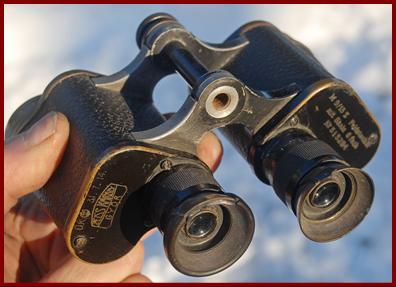
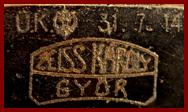




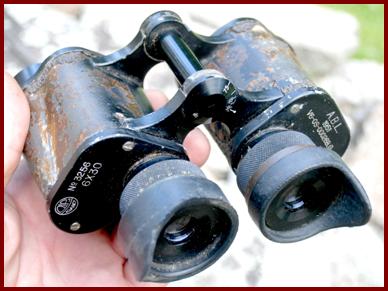
|
My 1951 OIP 6x30 binoculars are marked as having been made by O.I.P Gand , which is Optique et Instruments de Precision: an optical and instrument maker in Ghent Belgium (Gand is French language Ghent), founded in 1919. These Belgian military binoculars are marked as property of the A.B.L. ( Armee Belge-Belgish Legere/ Belgian Army) |
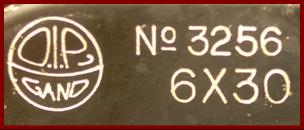
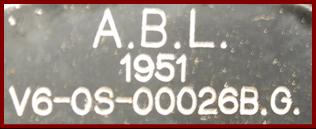
|
A.B. 8x38 Type 31 Belgian Military binoculars made by Optique et Instruments de Precision (O.I.P.) |
|
My OIP 8x38 type 31 Belgian Army binoculars are marked as having been made by O.I.P Gand , which is Optique et Instruments de Precision: an optical and instrument maker in Ghent Belgium (Gand is French for Ghent), founded in 1919. These Belgian military binoculars are marked as property of the A.B. ( Armee Belge), and type 31 binoculars are frequently described as being an artillery model, probably because of a very detailed vertical and horizontal grid that may be designed for shot fall correction. |
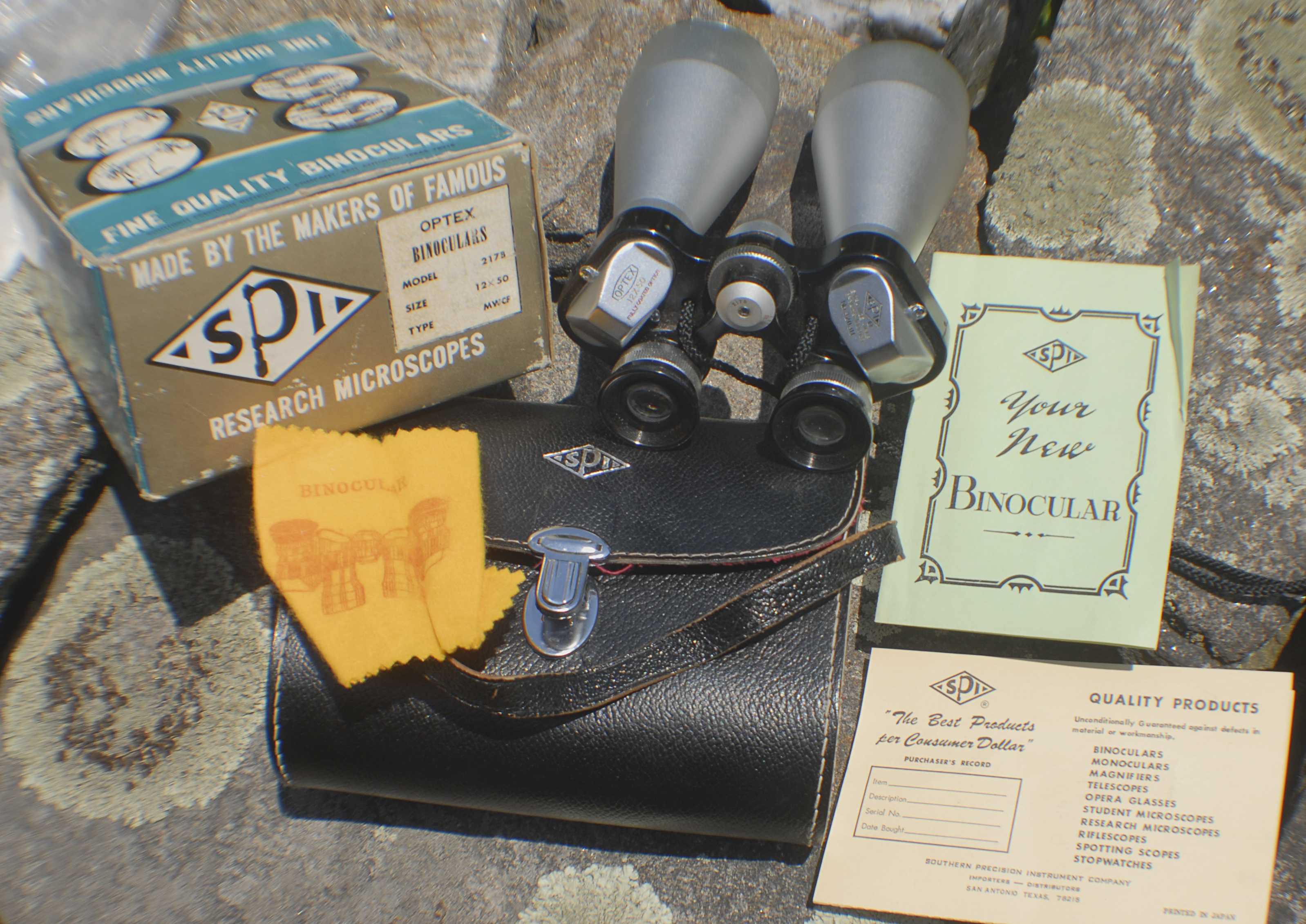
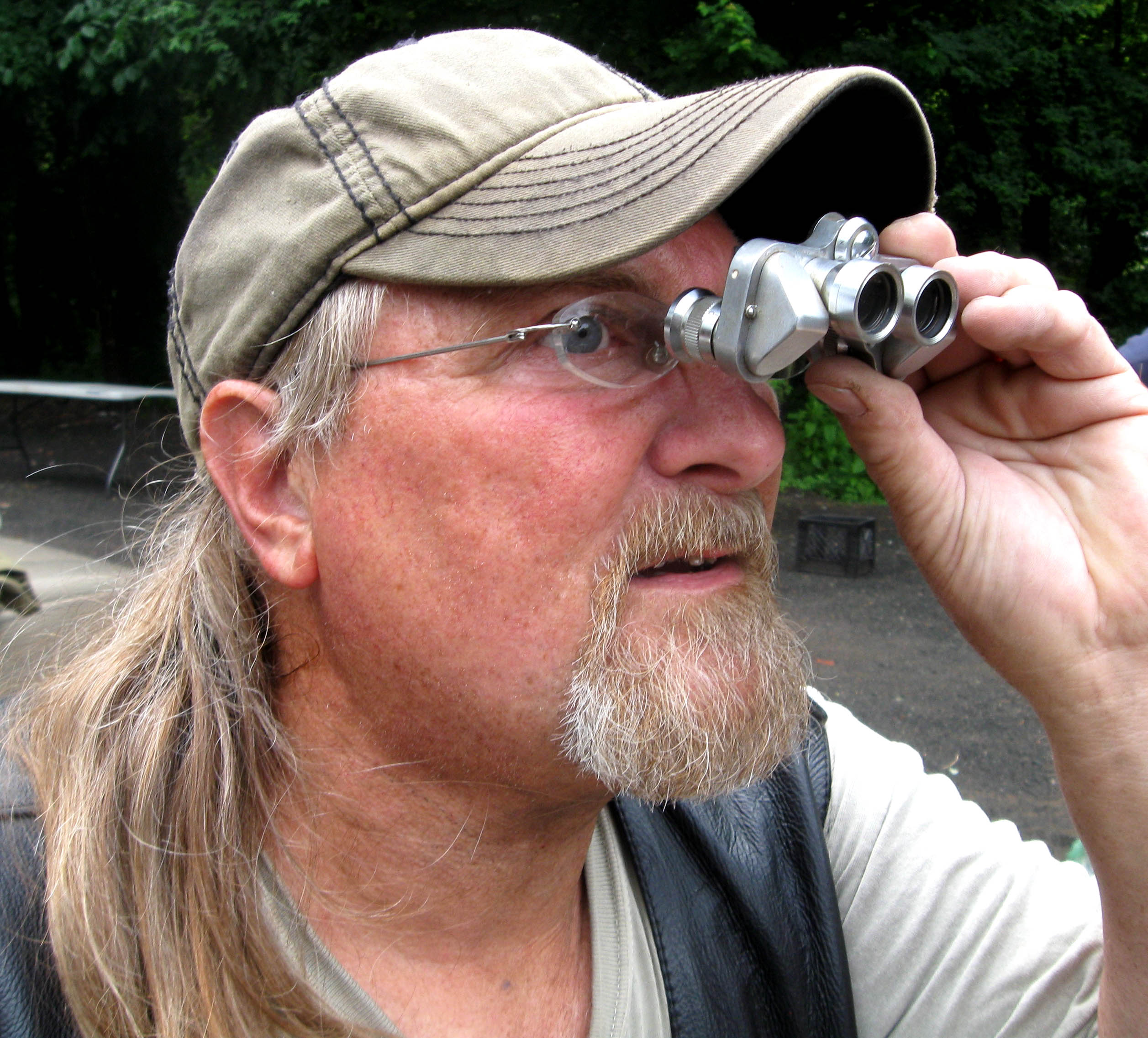
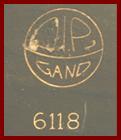
|
WWI G. Rodenstock Munchen Dienstglas D.F.03 6x24 German Military officers binoculars |


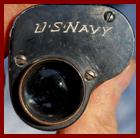
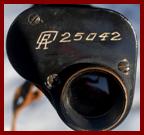

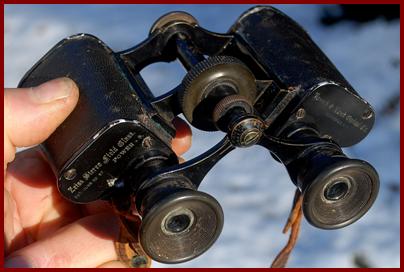
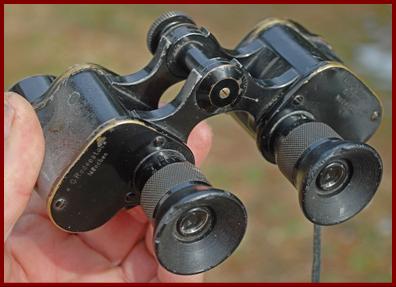
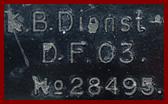

|
My G. Rodenstock D.F. 03 binoculars are standard WWI German military officers binoculars. “ K. B. Dienst .” is the abbreviation of K ö niglich Bayerisch Dienstglas” or Royal Bavarian {military} binoculars, and “ D.F. 03 ” is “Doppel Fernrohrglas 03”, or Double Telescope {model 03}, a military model produced starting around 1908 by many German binocular makers in WWI, with Rodenstock producing these in 1917-1918 (credit Hans Seeger). As the war progressed and model 08 non prismatic binoculars were issued to non commissioned officers, these were normally issued to infantry officers. |
|
G.Rodenstock is Optisches Institut G. Rodenstock, founded in 1877 |
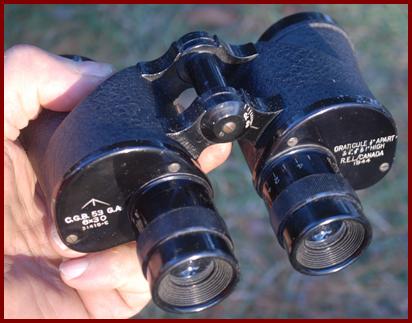
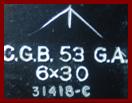

|
WWII Optisch Werk G Rodenstock Dienstglas ESO 6x30 German Military binoculars w/reticule |
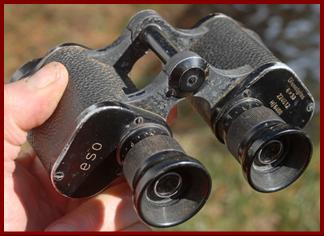

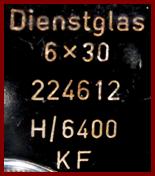
|
My WWII 6x30 German dienstglas military binoculars carry the eso wartime code of Optisch Werk G Rodenstock, and are standard pattern WWII German military binoculars with right ocular reticule/grid. My understanding is that these were brought back home to the USA by a member of the US Army Air Force 79th fighter group, Staff Sergeant John K Browning of Baltimore Maryland. The 79th fighter group was stationed in Egypt, Lybia, Tripoli, Tunisia, Malta, Sicily, Italy, and France during WWII, and then in Linz Austria during the occupation, and flew P40 and P47 Thunderbolt fighters. The binoculars are engraved with a letter and 12 digit inscribed Maryland drivers license number, a common anti theft practice in the 1950’s & 1960’s.The “KF ” (K ätelfest) marking indicates the use of late war cold weather Invarol lubricant, which was a product developed to cope with the extreme cold of the German invasion of Russia. This is another example of where binoculars (as an object or artifact) have interesting stories to reveal of their past. |
|
WWII Japanese Army 6 x military binoculars with reticule/grid |
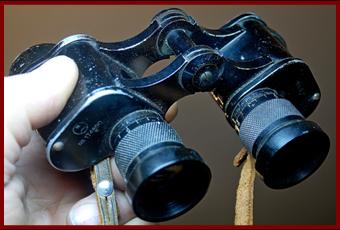
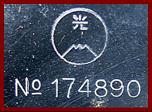

|
My Japanese 6x binoculars are Japanese army issued and have a right ocular reticule or ranging grid. These would be very typical of a US soldier bring back item, and virtually all Japanese binoculars in working condition that were encountered by US troops during the war with Japan were grabbed to use and to bring home. I have so far been unable to identify the logo, which the Google translation ap interprets as being a character for “rice”, over a representation of Mt Fuji ???? |
|
(outrageous) HONDA 50 cc “MONKEY” MOTORCYCLE MINI BIKE THAT I CREATED ?????? |

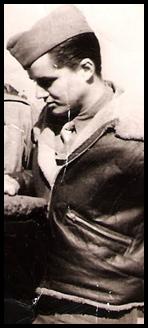
|
S/Sgt John K. Brownley 79th fighter group USAF |
|
1912 Russian Zeiss St. Petersburg DF 8x24 Russian Army military binoculars with reticule grid made or assembled in the Carl Zeiss St. Petersburg Russia facility. |
|
Zeiss Nedinsco D.v.D ( Departement van Defensie) Dutch Army military binoculars made in Zeiss licensed Granvenhage Netherlands factory |
|
My Nederlandse Instrumenten Compagnie Zeiss Nedinsco D.v.D marked 6x24 binoculars ( Departement van Defensie) or Department of Defence ca 1928 1941) were made in the 1930’s at the Zeiss licensed subsidiary Granvenhage Netherlands factory, founded in 1921, for issue by the Dutch army. |
|
1941 WWII SAFT Nife 5 x 25 Swedish Optical Gunsight for Kulsprutam M/36 8x63 mm Machine Gun |
|
My 1941 Nife Swedish medium machine gun optical sight is unusual in several aspects. First of all “Nife” was a trade marked brand name of SAFT Aktiebolag since 1916, and both this Swedish subsidiary and it’s French parent firm were primarily battery makers (and still are), and so all their various optical products produced in Sweden were almost an ancillary wartime product line. Optical sights on medium machine guns have never been commonly used elsewhere. The reason that Sweden put an optical sight with very complex compensating adjustments on their model 1936 Kulsprutam 8x63 mm Browning design based water cooled machine gun is because the Swedish military at that time were quite interested in indirect or plunging long range fire. (Medium and heavy machine guns are normally considered direct fire weapons). |
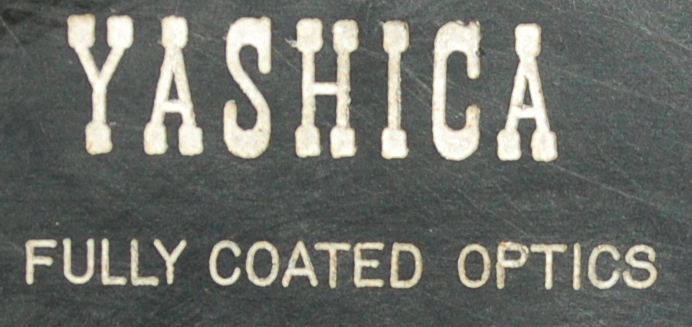
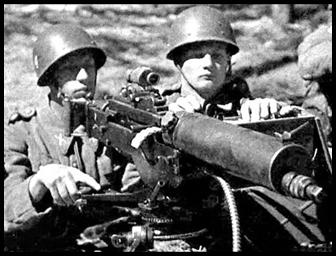
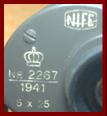


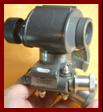

|
My 1912 Zeiss DF 8x24 military binoculars with right ocular reticule/ ranging grid were made at the Carl Zeiss St. Petersburg Russia facility, which had been established in 1911 as part of Carl Zeiss foreign assembly expansions By recommendation of the artillery committee of the GAU ( Главное артиллерийское управление (ГАУ – GAU ), these 8x binoculars were ordered by the Officer Rifle School to equip graduates of the artillery military schools from 1911-1913, while graduates of non artillery military schools received 6x models. (and in 1914 Russia standardized on 6x30 field binoculars for all). Only a small quantity of these 8x24 models are thought to still exist, given the small quantity produced for a small group of recipients, and given 110 years, revolution; imperial officer purges, and several wars. Serial number 296428 |
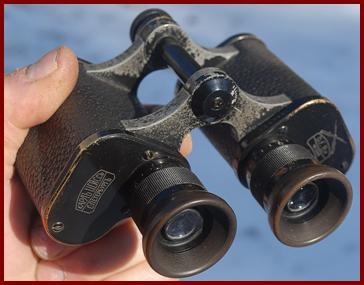

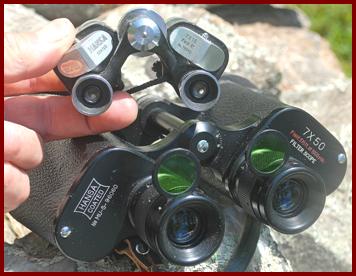
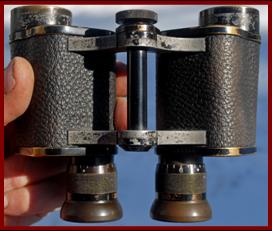

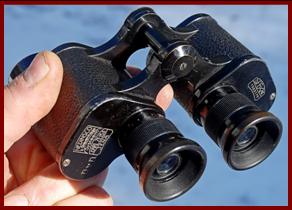
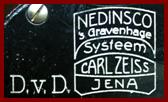

|
The Nederlandse Instrumenten Compagnie (known as Nedinsco) is a Dutch subsidiary of Zeiss that was founded in 1921, and which produced mostly military contract binoculars, when Germany was limited against producing war materiel by the WWI Versailles treaty. Nedinsco produced my 1926 6x30 binoculars serial number 1354243 under contract for the Argentine military/ Ej é rcito Argentino , for use of Infanty & Cavalry/ Infanteria y Caballeria . Obtained in Argentina. |
|
Israel Defense Force IDF contract Binolux 6x35 military binoculars |

|
My Binolux 6x35 binoculars carry the Israeli govt. property marks of letter Tsadi in circle and letter Nun in the star of david (also commonly seen on firearms Israel acquired in the 1950’s/1960’s for their military), and seem to be Binolux civilian spec binoculars purchased under an IDF /Israel Defense Forces contract. The T615184 is consistent with Binolux serial numbers, and the 81429 after the star of david property mark followed by no. in Hebrew is presumed to be a govt property number. |
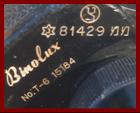



|
The German firm of Carl Zeiss had a formal company presence in London England starting in the 1840’s, in addition to their retail dealers, and in 1897 a Zeiss branch was advertised at 29 Margaret Street London West. On Nov 9, 1909 Carl Zeiss formally created a limited company in England, but with share capitol held by Carl Zeiss Jena Germany, and part of the reason for this was probably to pursue British government contracts as a UK entity. My 1913 dated Carl Zeiss London British Military Binoculars prove that Zeiss was assembling their No 3 Mk1 British designated military binoculars at their Mill Hill London factory facility in 1913, in order to fill UK Ministry of Defense (MOD) contracts. Their Mill Hill facility is shown left. (information credit to Thomas Antoniades/ “ Carl Zeiss Presence in London”). See also additional information about the activities of Zeiss London during WWI posted below with my 1916 No 3 Mk II Zeiss London military binoculars below. |
|
1913 pre WWI Carl Zeiss London British Military Binoculars 6x24 No.3 Mk 1 made in Zeiss UK factory |
|
Simpson’s mail order office, Sarnia, Ont., 1952. (Sears Canada. Photo Engravers and Electrotypers Ltd. Library and Archives Canada, e011172139 / Flickr), CC BY |
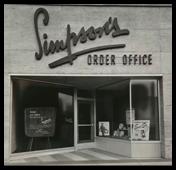
|
Simpsons ca 1952 |
|
1894 Carl Zeiss subsidiary in London Images donated as part of a GLAM collaboration with Carl Zeiss Microscopy . licensed cc by-sa 2.0 |

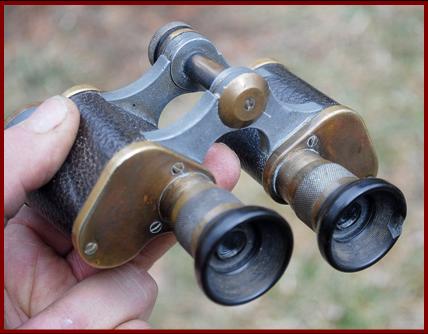
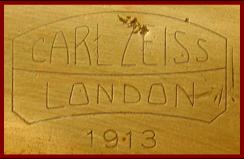

|
“ Binocular Prismatic No 3 Mark I magnification 6, (serial) No. 3945 ”. |
|
Carl Zeiss London 1913 marking |
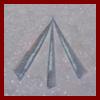
|
MOD broad arrow property mark |
|
Carl Zeiss London Mill Hill (Wikepedia Creative Commons) |
